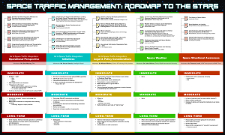Presentation Type
Paper (supporting PowerPoints may be added as Additional Files)
Location
Bass Auditorium
Start Date
26-2-2019 11:00 AM
Abstract
This paper explores commercial space vehicle (CSV) suborbital flight trajectories in the temporal and spatial domains for CSV integration into the National Airspace System. The research data was collected via the Suborbital Space Flight Simulator (SSFS) housed in the College of Aviation at Embry-Riddle Aeronautical University - Daytona Beach campus, and analyzed using an original MATLAB data analytics tool. This study primarily focuses on statistical trends observed in previously simulated flights supported by three Project PoSSUM (Polar Suborbital Science in the Upper Mesosphere) campaigns comprised of 34 flights and 19 control flights, and to identify relevant milestones in the CSV flight path. The correlations found in these flight milestones are key for the development of a predictive model for flight and ground safety operators, and reduce the necessity for extensively restricted flight hazard areas. In this paper, the PoSSUM and Control flights are compared to evaluate the deviation caused by different thrust operations conducted by the Scientist Astronaut Candidates (SACs) to enhance scientific data collection in the mesosphere. Preliminary results show the adjustments made by the PoSSUM flights have little affect in the domain with a mean difference of 10.4 seconds in time-of-flight (ToF) outside of the NAS, and a noticeable affect in the spatial domain with a mean difference of 9.3 km in the descent threshold range.
Area of Interest
NAS Integration
PPT in PDF format
STM_2019_HaysLlanosChu.pptx (4366 kB)
Original PPT
Included in
Aviation and Space Education Commons, Operational Research Commons, Space Vehicles Commons
A Statistical Approach for Commercial Space Vehicle Integration into the National Airspace System
Bass Auditorium
This paper explores commercial space vehicle (CSV) suborbital flight trajectories in the temporal and spatial domains for CSV integration into the National Airspace System. The research data was collected via the Suborbital Space Flight Simulator (SSFS) housed in the College of Aviation at Embry-Riddle Aeronautical University - Daytona Beach campus, and analyzed using an original MATLAB data analytics tool. This study primarily focuses on statistical trends observed in previously simulated flights supported by three Project PoSSUM (Polar Suborbital Science in the Upper Mesosphere) campaigns comprised of 34 flights and 19 control flights, and to identify relevant milestones in the CSV flight path. The correlations found in these flight milestones are key for the development of a predictive model for flight and ground safety operators, and reduce the necessity for extensively restricted flight hazard areas. In this paper, the PoSSUM and Control flights are compared to evaluate the deviation caused by different thrust operations conducted by the Scientist Astronaut Candidates (SACs) to enhance scientific data collection in the mesosphere. Preliminary results show the adjustments made by the PoSSUM flights have little affect in the domain with a mean difference of 10.4 seconds in time-of-flight (ToF) outside of the NAS, and a noticeable affect in the spatial domain with a mean difference of 9.3 km in the descent threshold range.



Comments
Visit the panel session NAS Integration Part 2: Suborbital and High Altitude Research